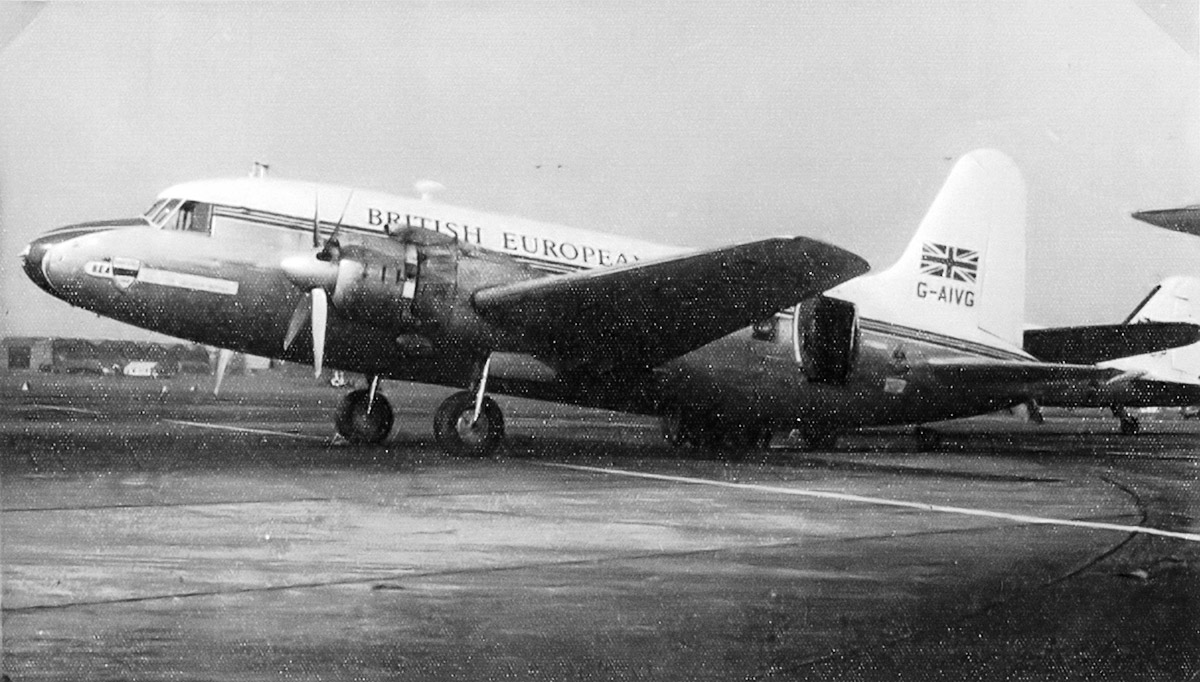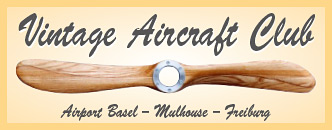This is only a short summary in English; please visit the German version of our website to find out more about the project, including the latest pictures.
A PDF of a two-page article which appeared in the 2020 edition of Propliner magazine and contains updated information on the project in English can be downloaded here.
On a sultry August afternoon in 1953 a Vickers 610 Viking 1B registered G-AIVG flying for British European Airways was involved in an accident during take off from Paris Le Bourget airport. More than 50 years later a group of enthusiasts are working on the remnants of this aircraft to restore it for permanent static display at Basel-Mulhouse airport. Recently two British museums have donated a complete landing gear and wheels to help to complete this audacious project.

Photo: Dave Cotterell archives
B.E.A. Viking G-AIVG was taking-off from Paris for London Heathrow on the afternoon of August 12, 1953 when it overran a piece of metal which caused the tyre of the right main undercarriage to burst. The resulting vibrations then caused the bolts to break and consequently in the right main gear’s collapse. The aircraft veered off the runway and after striking the ground with its right wing tip, it performed a pirouette. The 30 passengers and crew escaped unhurt but the aircraft was a write off. Subsequently it was gutted of all its vital parts including the engines and many instruments.
What happened from that time until the early 1970s when it arrived at the Musée Nationale d’Automobiles/ Colléction Schlumpf in Mulhouse, France, remains unknown to this day. For more than 30 years the fuselage, wings, fin and rudders were stored in a shed belonging to the museum. Some work was executed as there were plans to restore the aircraft and display it in a still to be created aviation section. However, these plans never materialised and the Viking’s hull and all the other parts belonging to it lay dormant and neglected for many years.
It was early in 2004 when the management of the museum decided to get rid of the Viking and sell it to an aviation museum. Response was scarce but two members of the local section of E.A.A. (Experimental Aircraft Association) Alsace showed their interest in taking over the Viking and its parts. In May 2004 the deal was concluded and the E.A.A. section at Basel-Mulhouse airport, happily signed a contract by which the Viking was officially handed over to them on condition that it would be restored as closely as possible to its original state. The goal, therefore, is to prepare it for permanent exhibit at Basel-Mulhouse airport which is situated in the three countries’ corner area of Switzerland, France and Germany.
On May 22, 2004 dismantling of the Viking in the museum began and it was made ready for transportation by lorry to Basel-Mulhouse airport where it arrived on June 16, 2004. Unfortunately the rough handling of some parts caused some more damage especially to the fabric-covered parts of the wings and rudder.
Soon afterwards a supporters’ association called Vintage Aircraft Club Basel Airport (V.A.C.) was founded. Funds were raised to buy material to start restoration work. A group consisting of various nationalities and trades – some of them retired mechanics but also pilots, teachers and travel agents – started to work first on the outside of the fuselage. Various coats of paint and dirt had to be removed with the help of gallons of WD40, a liquid facilitating this task a great deal. By removing these layers of paint the old BRITISH EUROPEAN AIRWAYS titles became visible again. They have been copied for possible re-application although it has not been decided yet in what colours the Viking should reappear. An alternative could be to repaint it in the period colours of Balair, a now defunct Swiss charter company which operated two Vickers Vikings from 1958 to 1963 on all-inclusive tour flights out of Basel.
Progress was slow at first, with only a handful people working mainly at the weekends. The lack of a professional aircraft engineer with the ability to give instructions resulted in the near standstill of the works in the years 2006 and 2007. However, with the retirement of a former Swiss Aviation Training School instructor, who readily joined the group, work rapidly picked up. Ever since midweek or Friday afternoon shifts have become scheduled duty times for most of our volunteers.
After a storm had done some more damage to the rudder and blown off some smaller parts, it was decided to move the fuselage for the nose to point into the main wind direction. A torrential rainfall almost caused the fuselage of the Viking to get flooded and so it became necessary to lift it off the ground. The tricky task of raising the fuselage above ground and thereby enabling work to be done on the badly-damaged underside of the hull was done with the help of an old scaffolding. This construction was adapted to its new purpose and fitted with a lifting device designed by our ingenious former Swiss Aviation Training School engineer.
A further hindrance is the fact that all the work has to be done in the open, be it in the scorching summer heat of the Upper Rhine valley or in the blustering cold winter winds often mixed with rain and sleet in winter. Although more than 50 members pay their monthly or yearly contributions, this does not allow the Vintage Aircraft Club to build a shed or even a hangar. So the fuselage, wings and other parts are stored in the open in an area of the airport which is not easily accessible to the public. Meanwhile, two old 20 foot containers have been bought and they serve to store some of the smaller parts of the Viking, tools, liquids and last but not least as a small workshop.
Lately, work executed on the Viking’s fuselage contained such things as the insulation of the interior with the help of polystyrene panels and sheet metal work to cover up a big hole that was cut into the rear fuselage when the Viking was still with the Musée d’Automobiles in Mulhouse. This circle-shaped hole was cut out because plans existed to raise the Viking high above the ground and make it accessible by a spiral staircase. Another task lately finished is the re-installation of the radio rack which has been re-painted in its original black colour. Meanwhile the cockpit interior is resplendent in the original mint green colour. The original windows having been replaced by acrylic glass windows, the old ones now await attention in a nearby workshop.
Fantastic work has again been done by our instrument mechanic who refurbished the cockpit instruments and meanwhile the cockpit panels have been re-installed to house these instruments. Also the original cockpit windows have been put back in place and soon the pilot’s seats will be back in their original positions.
Although no engines were left, there were two propellers delivered together with the wings and the engine nacelles when the aircraft was ferried to Basel airport in June 2004. It is, however, doubtful whether these propellers were originally driven by the Bristol Hercules sleeve valve engines. Their pitch hints to their turning anti-clockwise which would be unusual for this type of engine. Also the tail wheel has been saved and could be refitted in its place without great difficulty. However, the absence of the two main gears lost in the accident in 1953 would put the completion of the Viking in question.
Consequently one of our historical minded members set off to trace two main gears. Upon a visit to several British aircraft museums he was successful in finding one complete leg with a wheel in the Norfolk and Suffolk Aviation Museum in Flixton. If a second gear could be found this would enable our Viking to literally stand on its own feet again! This other gear could be found in the North East Aircraft Museum in Sunderland. Both these legs were left from a Vickers Valetta (VX577) which had been on exhibit at the North East Aircraft Museum in Sunderland and which was almost completely destroyed by an attack of arsonists in the early 90s. The remaining parts of that Valetta were then kept in store in Sunderland and one leg and wheel were given to the Norfolk and Suffolk Air Museum in Flixton.
In autumn last year negotiations with both museums began and it was mainly because of the generous and kind attitude towards our project by both chairmen Mr Hugh Newell in Sunderland and Mr Ian Hancock that finally both museum’s board members could be convinced to donate these two vital parts for the completion of the “Swiss” Viking in Basel.
In March this year the two legs and wheels were transported by lorry to Basel where their arrival was heartily welcomed and undoubtedly will give further motivation to pursue the restoration of the Viking with even more zeal.
Needless to say the Viking restoration project is still far from completion. There will probably be another three to four years of intensive work. But recently the airport authorities of Basel-Mulhouse airport (EuroAirport) have shown interest in the Viking and discussions are under way to find a place for permanent display. A suitable place for display of this early modern airliner could be an old wooden hangar dating back to the forties where the Vikings of Balair were once maintained. Hopefully this hangar will be saved and give a permanent shelter for the sole surviving Viking on the continent.
Text: Peter F. Peyer, autumn 2010
